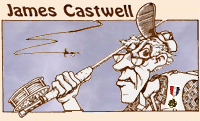|
Many times a casting instructor will have a student
turn his head and watch his own back-cast. This is
often a fine idea, I have used it many times. If a
guy will watch three back-casts in a row, he will
be amazed at how quickly he can correct bad loops,
poor timing or low line speed.
But, he may introduce a new problem, sometimes more
than one. When a back-cast is too big and wafting,
turning and watching may encourage a harder stroke
and harder stop, more line speed or better timing,
but it will almost cause the reel to swing out to
the side and the casting shoulder to drop. Both of
these are to be avoided.
Sometime when you are 'lawn' casting with a buddy,
stand directly in front of him, but far enough out
so you don't get in the way of his cast and watch
his back-cast. More often than not you will see his
forward cast come straight at you and his back-cast
will be more of an oval, off to his right side,
very inefficient.
When you are casting, coming back with the rod into
the back-cast, the rod is bent toward the front,
the guides are on the bottom, your thumb (usually)
is on top of the grip, (knuckles facing you) and
the reel is pointed down. As you come back and are
turning your head to watch your fly-line, the tendency
is to drop your right shoulder, the back of your
thumb now faces you (knuckles are now hidden) and
with the reel is now pointed away from you.
If you are casting a long line, as the cast stops
you may find your reel actually pointing straight
back. This is not a 'good thing.' When you start
the cast, let's say the reel is below the rod at
a position of 7 o'clock and at the end of a long
line cast it should be at 11 o'clock, maybe even
12 o'clock. At the back 'stop' the reel should be
between 10 and 11 o'clock and a drift to (straight
up) 12 o'clock. The reel should not change in the
plane it travels. Because the rod was bent down at
the start of the cast it should travel directly back
also without changing it's plane so the tip can
unload (recoil) directly back without any twisting.
All of this will increase your line speed and
efficiency. But, it is not always easy to make
all of this happen. You might even need to learn
how and actually practice to make it a regular
part of how you cast. If you have a chance to
watch some of the truly great fly-casters, Randi
Swisher comes immediately to my mind, look for
that little piece of the cast. Due to personal
choices of grip, some may start out with the reel
a bit off to the side but, it will stay in the
same plane all the way. It is simply the most
efficient way to do it.
If you have trouble getting your cast to perform
well, you might try this. Stand with both feet side
by side, touching, pointing straight ahead. No,
you will not fish this way, we're working on
something here, ok? Start casting and as you
bring the rod back into the back-cast, slightly
tighten your grip and squeeze your fingers toward
you. This will slightly twist the rod handle and
help keep the rod and reel in the same plane and
not swinging out. A bit of practice will make this
seem natural. Now with that at least somewhat under
control, step into your normal comfortable casting
stance but, for six casts in a row, totally control
the plane of the rod and reel, keeping it in proper
alignment.
Many of these are small trivial things, but when
rolled together can make a big difference in your
overall casting. Heck, at least you will look better.
~ James Castwell
|



